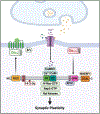RGS14 expression in CA2 hippocampus, amygdala, and basal ganglia: Implications for human brain physiology and disease
- PMID: 36541898
- PMCID: PMC9974931
- DOI: 10.1002/hipo.23492
RGS14 expression in CA2 hippocampus, amygdala, and basal ganglia: Implications for human brain physiology and disease
Abstract
RGS14 is a multifunctional scaffolding protein that is highly expressed within postsynaptic spines of pyramidal neurons in hippocampal area CA2. Known roles of RGS14 in CA2 include regulating G protein, H-Ras/ERK, and calcium signaling pathways to serve as a natural suppressor of synaptic plasticity and postsynaptic signaling. RGS14 also shows marked postsynaptic expression in major structures of the limbic system and basal ganglia, including the amygdala and both the ventral and dorsal subdivisions of the striatum. In this review, we discuss the signaling functions of RGS14 and its role in postsynaptic strength (long-term potentiation) and spine structural plasticity in CA2 hippocampal neurons, and how RGS14 suppression of plasticity impacts linked behaviors such as spatial learning, object memory, and fear conditioning. We also review RGS14 expression in the limbic system and basal ganglia and speculate on its possible roles in regulating plasticity in these regions, with a focus on behaviors related to emotion and motivation. Finally, we explore the functional implications of RGS14 in various brain circuits and speculate on its possible roles in certain disease states such as hippocampal seizures, addiction, and anxiety disorders.
Keywords: RGS proteins; RGS14; amygdala; basal ganglia; hippocampus; limbic system; striatum; synaptic plasticity.
© 2022 Wiley Periodicals LLC.
Figures




References
-
- Bandelow B, & Michaelis S (2015). Epidemiology of anxiety disorders in the 21st century. Dialogues Clin Neurosci, 17(3), 327–335. Retrieved from https://www.ncbi.nlm.nih.gov/pubmed/26487813 - PMC - PubMed
Publication types
MeSH terms
Substances
Grants and funding
LinkOut - more resources
Full Text Sources
Molecular Biology Databases
Miscellaneous

